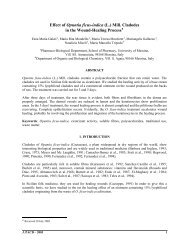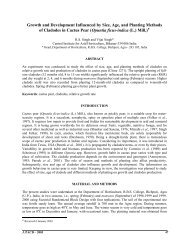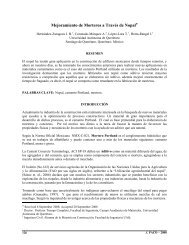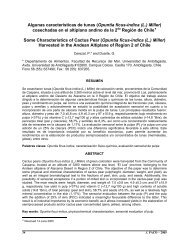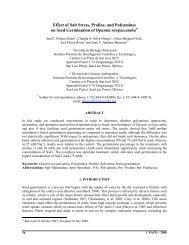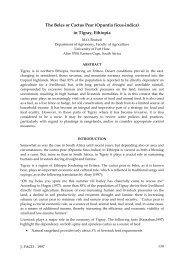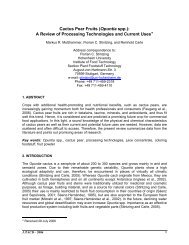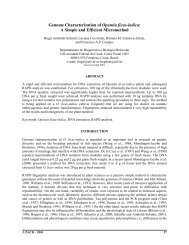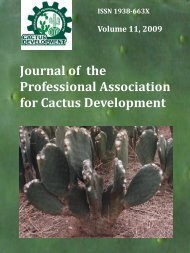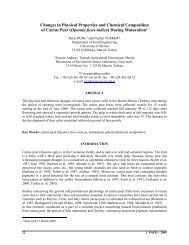Pectins from Opuntia spp.: A Short Review
Pectins from Opuntia spp.: A Short Review
Pectins from Opuntia spp.: A Short Review
Create successful ePaper yourself
Turn your PDF publications into a flip-book with our unique Google optimized e-Paper software.
give a xylose-to-arabinose ratio of ∼1:2. This ratio seems to hold in close agreement with data formucilage extracts analyzed in the more recent studies of Brito and co-workers (Medina-Torres et al.2000) (xyl:ara ~1.8) and Majdoub et al. (Majdoub et al. 2001) (xyl:ara ~2.0), but not with our own extract(xyl:ara ~0.17) included in Table 2. This chemical composition shows great similarities to that of thehighly branched regions (“hairy” regions) of cell-wall pectins, particularly to the rhamnogalacturonan I(RG-I) fraction (Pellerin et al. 1996; Voragen et al. 1995). In light of this close resemblance, mucilage<strong>from</strong> <strong>Opuntia</strong> and other cacti, are indistinctly referred to as pectins. However, up to now, the mucilagepolysaccharides in <strong>Opuntia</strong>, do not seem to be chemically associated, either covalently or otherwise, tothe structural cell-wall pectins. Instead, it has been proposed that mucilage biosynthesis takes place inspecialized cells which excrete it into the apoplast where it helps to regulate the cellular water contentduring the initial phase of dehydration (Nobel et al. 1992). Its physiological role has been associated withtheir ability to bind water under unfavorable climatic conditions (Mindt et al. 1975). It has also beensuggested that the mucilage has a predominant role in the Ca 2+ economy of the plant (Trachtenberg andMayer 1981). The major characteristics of these two distinctive families of polysaccharides are reviewedin the following sections.Properties of Nopal MucilageMajdoub et al. (2001), have recently addressed the problem of trying to understand the relationshipbetween the structure and the properties of the pectin of peeled prickly pear. The material that theseauthors evaluated was the aqueous extract of macerated peeled nopals. Its composition is shown inTable 2. Two polymeric components were identified in the purified extract by size-exclusionchromatography (SEC) coupled to double detection by refractive index (RI) and multiangle laser lightscattering (MALLS) in 0.1M LiNO 3 , namely a high-molecular-weight fraction (~10% by weight) and alow-molecular-weight fraction (~90% by weight). The two populations of molecular species wereseparated satisfactorily in a different experiment by subjecting the native sample to ultrafiltration againstdeionized water during a week and using a series of membranes with a molecular weight cut-off of100,000 g mol -1 . The material retained by the membrane (HWS) had a high weight-average molar mass(M w ~14.2 × 10 6 ), while the filtrate (LWS) had a low M w ~4000. LWS comprised predominantly proteinspecies (~80% by weight), while no protein was detected in the HWS fraction. Therefore, the majorcomponents of the native mucilage extract are low-molecular-weight proteins. Although it is notexplicitly discussed in the paper of Majdoub et al. (2001), the likely reason why proteins are not removedduring the extraction is that the extract was not precipitated with ethanol (cf. Figure 2). The nature of theproteins present in nonprecipitated nopal mucilage extract is mostly unknown and <strong>from</strong> their size andpoor water solubility only inferences have been made, so that they have been compared with the 2Salbumin storage family proteins present in the seeds of O. ficus-indica (Uschoa et al. 1998). That proteinsare essentially associated only to LWS, was demonstrated by an experiment in which the native samplewas subjected to the activity of pronase. Only species in LWS were hydrolyzed, while HWSpolysaccharide fraction was not affected. The resistance of HWS to pronase activity is in contrast with thewell-known arabinogalactan protein (AGP) complex present in gum arabic, in which the protein speciesare associated to the high-molecular-weight fractions (Connolly et al. 1988). AGP macromolecularassemblies of varying molecular size in gum arabic are key to its unique functionality, namely, thecapacity to lower the oil-water interfacial tension, and hence to create the emulsifying capacity in oil-inwateremulsions (Dickinson and Galazka 1991; Dickinson et al. 1991; Ray et al. 1995). Nevertheless,proteins themselves are also known to be effective emulsifiers, hence, the potential surface activity ofnopal mucilage cannot be ruled out on these grounds. To our knowledge, the surface properties of nopalmucilage so far have not been tested.22 J. PACD – 2003



